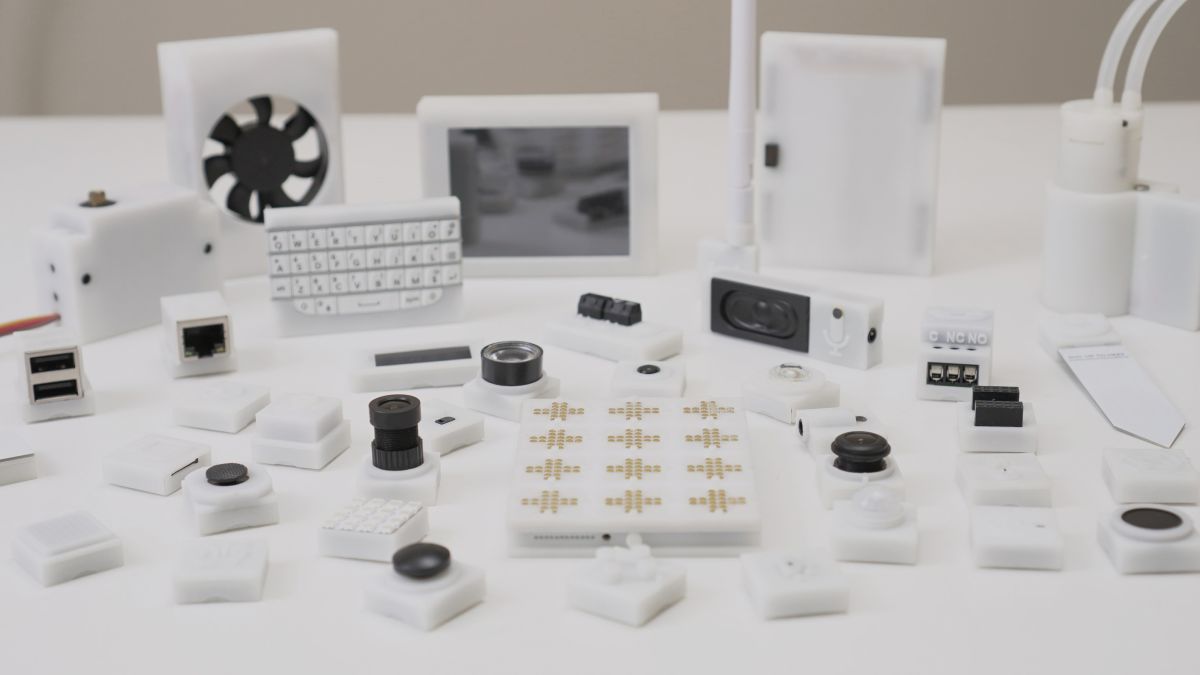
This Mini Modular Computer Helps You Build Gadgets From Scratch
[ad_1]

DIY modular gadgets are nothing new, but they’ve had varying amounts of success over the years. Some devices managed to pick up steam, like AIAIAI’s TMA-2 headphones, while others, like the Blocks smartwatch and Google’s modular phone, crashed and burned. Mixed success in designing and launching these devices isn’t stopping others from creating new modular devices though, nor should it. Anil Reddy, creator of Pockit, a tiny modular computer that you can turn into various types of gadgets, may have actually created a must-have. At the very least, it looks so gosh darn cool.
Think of Pockit like a kit of electronic Legos. Starting with a magnetized base-board about the size of a credit card, users can “snap” tiny SLA 3D-printed blocks on top to create clocks, Bitcoin tickers, thermostats, cameras, automatic watering devices for indoor plants—virtually anything, even a plug-and-play Linux computer with a Raspberry Pi.
Some blocks have raised icons on top to let you know if they are made for specific use-cases like those. Some blocks have a teeny, tiny circuit board inside, along with a coin-sized battery commonly used in a bunch of different devices like garage door openers, watches, and motherboards. Some blocks double as controllers or a keyboard. No one needs to be a coding wizard to build a Pockit module, either.
“Pockit auto-shapes its behavior based on the connected blocks,” Reddy told Gizmodo.
In other words, Pockit has the ability to program itself by recognizing what blocks are connected and how they are configured on the board. For instance, if you connect an LED block and a button block, then Pockit knows you want that button block to turn that LED on and off. Reddy says this auto-adaptive behavior makes creating more complex gadgets like a smart thermostat or a gardening controller easier because the modular device already knows what blocks go together.
G/O Media may get a commission
Reddy spent his early days as an embedded engineer, designing all sorts of projects from scratch using those exact, and sometimes painstaking, processes. A lot of people have great ideas for gadgets, even if they only want to make one for themselves, but soldering and coding alone take a while to learn. Reddy wanted to give electronic DIYers an easier way to create gadgets where their only limit would be their creativity.
“Unlike building a desk or even a website, it’s unimaginable for most people to make an electronic device. Buying chips, reading documentation, wiring, soldering, coding, debugging, and you’re already a few weeks in,” Reddy said.
But he hasn’t forgotten about users who might be more advanced coders. For anyone looking to fine-tune a Pockit device, you can program it using simple, English-like statements or C++. Reddy is currently working on an English-like/natural-language syntax system he calls nCode (natural code), which he said is close to being finished.
There are some practical limitations to Pockit. It’s not waterproof, and while it’s a great way for kids to get into building electronics, the small pieces do pose a choking hazard for young children. (It’s not a toy.) The number of blocks in the Pockit ecosystem are limited to 24 at the moment, but Reddy says he’s working on others, like a thermal camera block and a weight sensor block. Reddy also said Pockit isn’t designed for gaming, but since it’s wifi and Bluetooth LE-ready, maybe someone will eventually figure out a way to play games in the cloud.
The Pockit already seems like a fully-fleshed out modular device, but it’s not quite ready to make its debut. Reddy plans to release a small batch of early-testing kits at the end of the month. From there, after gathering feedback and refining Pockit even further, Reddy will launch a preorder campaign so more people can get their hands on the device and build their own gadgets.
[ad_2]
Source link







